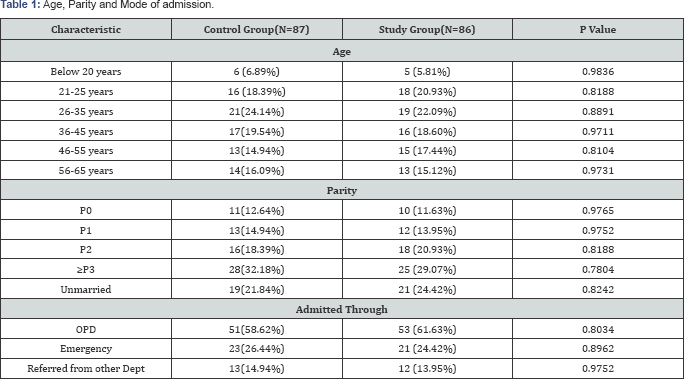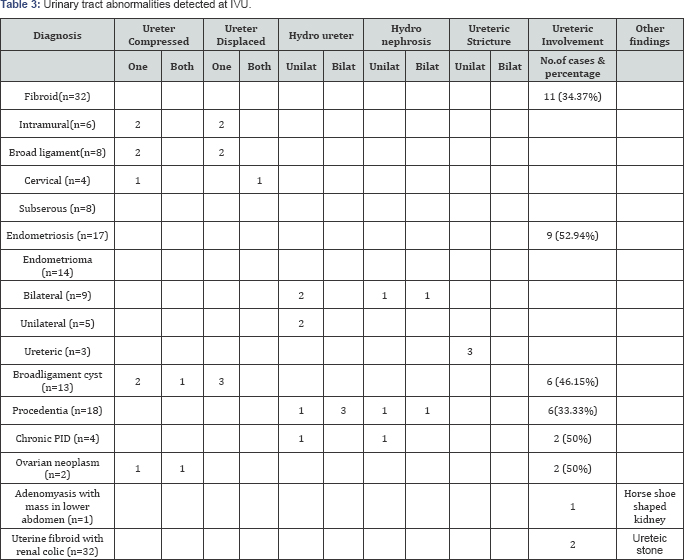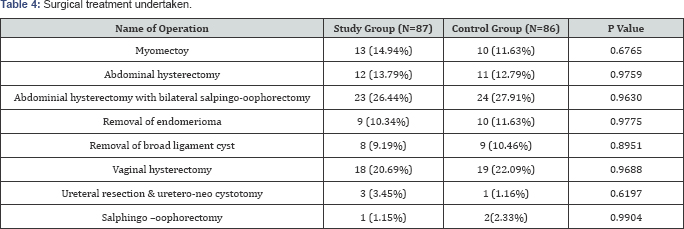Juniper Publishers: The Role of Pre-Operative Intravenous Urography in Preventing Urinary Tract Injury for Benign Pelvic Lesion
JUNIPER PUBLISHERS- JOURNAL OF GYNECOLOGY AND WOMEN’S
HEALTH
Journal of Gynecology and Women’s Health-Juniper
Publishers
Authored by Shyama Prasad Saha*
The Role of Pre-Operative Intravenous Urography in Preventing Urinary Tract Injury for Benign Pelvic Lesion
Shyama Prasad Saha1*, Goutam Mukherjee1, Anuradha De2, Shyamapada Pati3 and Tapan Lahiri4
1Department of Obstetrics & Gynaecology, North Bengal Medical College, India2Department of Pathology, RG Kar Medical College, India
3Department of Obstetrics & Gynaecology, National Medical College, India
4Department of Obstetrics & Gynaecology, Institute of Postgraduate Medical Education and & Research, India
Submission: November 25, 2016; Published: February 03, 2017
*Corresponding author: Shyama Prasad Saha, B-3 Hospital Quarter, North Bengal Medical College, Sushrutanagar, Darjeeling, West Bengal, India, Pin: 734012; Tel: +919434142645; Email: drsps94@gmail.com/drsps_94@yahoo.com
How to cite this article: Shyama P S, Goutam M, Anuradha D, Shyamapada P, Tapan L. The Role of Pre-Operative Intravenous Urography in Preventing Urinary Tract Injury for Benign Pelvic Lesion. J Gynecol Women's Health. 2017; 2(2): 555585. DOI: 10.19080/JGWH.2017.02.555585
Abstract
Due to close anatomical proximity of female urinary
and genital tract, the ureter, urinary bladder and urethra are
vulnerable for injury during gynaecological surgery. In a comparative
observational study we evaluated 89cases having benign and clinically
high risk gynaecological conditions requiring surgery, for the incidence
of urinary tract involvement and to determine whether pre-operative
assessment of urinary tract by IVU diminishes the risk of operative
injury. At what circumstances IVU will be justifiable is also evaluated.
In our study IVU could detect urinary tract involvement in 41.37% cases
preoperatively in selected benign gynaecological condition. In the
study group 2 patients sustained intraoperative urinary tract injury
whereas 5 cases in control group had the same.
It is evident from our study that IVU can detect
urinary tract anomaly in large number of patients in comparison to
control group; the information available to gynecologist allow him/her
to take steps to either prevent or detect ureteric injury during
operation.
Keywords: Intravenous urography; Benign; Pelvic lesion; Pre-operativeIntroduction
The urinary and genital system develop from a common
intermediate mesodermal ridge; therefore the anatomical proximity of
female urinary and genital tract make the ureter, urinary bladder and
urethra vulnerable to injury during gynaecological surgery.
Ureteric injury is one of the most serious
complications during major gynaecological and pelvic surgery; the
incidence varying from 0.4 – 2.5% for benign condition Drake & Nobel
[1]. Obstetric and gynecological surgeries account for approximately 50 % of ureteric injuries Fry et al. [2]
Apart from surgical trauma either from difficult surgery or careless
surgery, urinary tract is much more liable to be injured with
endometriosis, enlarged pelvic tumour, previous pelvic surgery, pelvic
adhesion, pelvic inflammatory disease, distorted pelvic anatomy,
advanced malignancy, previous radiation Harkki-Siren [3]. Carley et al. [4]
reported that the incidence of bladder and ureteric injuries were 0.58%
and 0% for vaginal hysterectomy respectively and the same was 5.13% and
1.71% respectively for obstetric hysterectomy Carley et al. [4].
The pelvic surgeon should have a thorough knowledge
and complete familiarity with normal pelvic anatomy. The pelvic
pathology must be evaluated by clinical examination and supportive
imaging as a preliminary step before any pelvic surgery. The decision to
obtain a routine intravenous urogram (IVU) for evaluation of course of
ureter before hysterectomy for non-malignant conditions has not been
proven till date. No such randomized trial has been conducted till date
to prove its application.
Aim and Objective
The aims and objectives of this study were directed to evaluate:
- The involvement of urinary tract in benign and clinically high risk gynaecological conditions requiring surgery.
- Whether pre-operative assessment of urinary tract by IVU diminishes the risk of operative injury.
- At what circumstances IVU will be justifiable.
Material and Methods
Settings
This study was conducted at North Bengal Medical
College, Darjeeling and I. P.G.M.E.R, Kolkata over a period of three
years from 1st June, 2007 to 31st May, 2010.
Design
This was a comparative observational study.
Population
The subjects of the study were selected from gynaecological outpatient department of those institutes mentioned above.
A group of 89 women with different benign
gynecological conditions requiring surgery who underwent IVU were
selected for study group.
Inclusion criteria for this study were as follows:
- Abdominal mass corresponding with ≥14 weeks size of pregnant uterus
- Adnexal mass along with pain radiating from loin to groin.
- Acute retention of urine with pelvi-abdominal mass.
- All cases of uterine procedentia.
- Pelvic retroperitoneal mass requiring surgery
- Gynecological lesion associated with urinary tract abnormality detected incidentally by USG or CT scan.
- Exclusion criteria were impaired renal function test and hypersensitivity to iodine containing dye and suspected malignant lesions.
A cohort of similar number of patients having similar
demographic profile and same inclusion criteria were selected for
control group for whom IVU was not performed. History taking, clinical
examination, pre operative evaluation and work-up were planned.
Information regarding age, marital status, fertility and parity were
also noted. USG whole abdomen was performed in patients of both groups.
CT scan of abdomen was also done where situation demanded. All subjects
underwent urinary analysis and renal function assessment. Preoperative
IVU findings (in study group) were documented properly. DTPA (Diethylene
Triamine Pentacaetic Acid) scan was performed for cases of non
functioning kidney detected by IVU. A comprehensive approach for the
gynecological and urological surgery was undertaken in consultation with
urological surgeon. The site and type of ureteric injuries recognized
at operation for both group were recorded.
Intra-operative, post operative findings and
complications in relation to urinary tract were recorded for both groups
and compared. Primary outcome measure in this study was incidence of
urinary tract involvement in benign gynaecological conditions. Secondary
outcome measures were incidence of intra-operative and post- operative
urinary tract injuries of both groups and to observe whether
pre-operative IVU could reduce such complication.
Two patients in study group and three patients in
control group later on were found to be suffering from malignant
conditions and excluded from result analysis. So 87 in study group and
86 in control group were evaluated and analysed.
Statistical analysis
The data were analysed using Medical Statistical
Software Statistical analysis included Chi-square test and’t’ test to
compare the outcomes between the study group and the control group. A
p-value less than 0.05 were considered as statistically significant.
Results



Patients in both groups were comparable in relation to age distribution, marital status, parity and mode of admission (Table 1). Table 2 shows distribution of cases in both groups which are also comparable. Table 3
showed the diagnosis and urinary tract abnormalities by IVU in the
study group. Out of 87 cases, IVU could detect urinary tract involvement
in 41.3% case. Two patients with uterine fibroid had renal colic and
detected to have calculus in ureter, whereas one case of horse- shoe
shaped kidney was seen by IVU in a patient of adenomyosis.
Table 4
depicted the different surgeries performed in both groups which were
comparable. Intra-operative and postoperative urinary tract injury had
been shown in Table 5 & 6
respectively. In the study group only two patients had intra-operative
ureteric injuries whereas in control group five patients sustained
ureteric injury.



Discussion
Several studies have defined the prevalence of abnormal preoperative IVU in gynaecological conditions. Roden et al. [5] noted 15.3 % genitourinary anomalies in 455 patient undergoing major pelvic surgeries Roden et al. [5]. Schartz et al. [6] found 13.4% prevalence of genitourinary involvement in their study Schartz et al. [7]. 14.2% prevalence of genitourinary abnormality was reported for all type of gynaecological surgery by Klissaristos et al. [8] whereas Piscitelli et al. [10] in retrospective review found 27% abnormal finding in pre-operative IVU Klissaristos et al. [8]; Piscitelli et al. [10].
Our finding was 41.37% in study group and was higher; this might be due
to inclusion of selected cases like pelvic mass more than 14 weeks and
referred cases and also routine IVU was not used as a diagnostic tool.
Large intramural leiomyoma occupying above the
pelvis, broad ligament fibroid and cervical fibroid had caused
compression and displacement of ureter in 34.37 % in our study. In a
retrospective study at Duke university medical center the authors
reported 20% prevalence of ureteral dilatation and 10% of ureteral
deviation by uterine size 12 weeks or larger. Larger fibroid above
pelvic brim causing obstruction had been disputed in a study which
showed only significant obstruction in only 9 cases out of 598 patients
with fibroid of all sizes Buchsbaum & Schmidt [11]. Ureteral obstruction by extrinsic compression is reported by large pelvic tumour most commonly leiomyoma Thompson [12].
Intra-ligamentary fibroid is relatively fixed and because of their
position can cause ureteral displacement and obstruction Barnik &
Cardizo [13]. Once the pelvic mass has been removed the radiography changes rapidly revert to normal Barnik & Cardizo [13]. Our study conform to these studies.
Marked dilatation of ureter and hydronephrosis had
been reported when complete uterine procidentia had been chronic over
many years. We had noted hydroureter and hydronephrosis in 33.33% of
patient in our study group; most of them were long standing for five
years or more. Rudin et al. [14] studied 95 patients with uterine prolapse and found 7% prevalence of hydro-ureteronephrosis Rudin et al. [14]. Jones and Evison reported a huge 66% prevalence of ureteral dilatation in patient with sever procidentia Jones & Evison [15]. Third degree prolapse with 17 % hydroureter was noted in a study at Duke University medical center Piscitelli et al. [10]
The prevalence of mild, moderate and severe hydronephrosis with pelvic
organ prolapse were detected in 4%, 2.8% and 0.9% of subjects
respectively by Baverly et al in a study of 375 patient of genitor
urinary prolapse Beverley et al. [16]. The obstruction is usually relieved by surgical correction Thompson [17].
The true incidence of urinary complication with endometriosis is
neither known nor all sufferers were fully urologically investigated. We
observed 34% of the patients of ovarian endometriosis had ureteric
dilatation and hydronephrosis. Thomson and Schroder suggested that it is
important to consider urinary tract involvement in all cases of severe
endometriosis Thomson & Schroder [12].
To date over 100 cases of ureteral involvement by endometriosis had
been reported. About 25% kidney are lost when endometriosis obstruct the
ureter Moore et al. [18]. Prevalence of 18% ureteral dilatation patients was reported out of 16 patients Piscitelli et al. [10]. It is recommended that routine IVU or ultrasound follow up after treatment of endometriosis is required Miller & Morgan [19].
In extrinsic involvement the ureter becomes compressed by endometriosis
originating at broad ligament or ovary. In intrinsic involvement the
endometriotic implant arises within ureteric wall and some portion of
ureter has to be resected Barnik & Cardizo [13]. In our study three such cases were observed and ureteroneocystostomy was done in the study group.
Chronic Pelvic inflammatory disease with adenexal
mass had caused hydroureter and hydronephrosis in 2 out of 4 cases in
our study group. In one study preoperative IVU in 44 patients with
tubo-ovarian abscess, ureteral dilatation & deviation were observed
in 30% and 36% patients respectively (Phillips, 1974). In another
similar study, out of 34 patients of PID with adenexal mass, 21% had
ureteral dilatation and 9 % had deviation Piscitelli et al. [10]. In our series out of 4 cases of PID, two had hydroureter.
Large ovarian neoplasm, can cause pressure effect on
the ureter leading to obstruction, as they tend to be cystic and mould
to the contour of the pelvis Barnik & Cardizo [13].
The incidence of benign tumour causing ureteral obstruction was 57.8%
in the same study. We noted in two patients of ovarian tumour had caused
ureteric compression in our study.
In our study group two patients had intra-operative
ureteric injury of which one had contusion of ureter in a case of
central cervical fibroid and another had crushing injury in a case of
pelvic inflammatory disease with tubo-ovarian mass. They were managed
conservatively and by uretero neocystotomy respectively. There was no
unrecognized urinary injury in this group during operation. In the
control group a total of five cases had different types of ureteric
injuries during operation which include contusion, inclusion in a
ligature and crushing injury. In two cases of huge broad ligament cyst
we had crushing injuries of ureter which were managed conservatively.
Ureter was included in the ligature in a case of central cervical
fibroid which was detected during the operation and treated by excision
and end to end anastomosis. In two cases of bilateral endometrioma of
ovary with gross pelvic adhesion, ureter of left side were crushed and
managed by uretero neocystostomy.
Ureteric injuries were recognized during
convalescence in two patients of control group but none in the study
group. In a case of severe pelvic inflammatory disease with tubo-ovarian
mass, ureter was devided in its lower part and patient developed
urinoma which was managed by drainage of urinoma and later by
ureteroneocystostomy. In another case of severe endometriosis, left
ureter was involved in the ligature and ureteroneoureterostomy was
performed later.
Numerous studies reported the frequency of ureteric
injury related to hysterectomy. Not a single study conclusively stated
whether a preoperative IVU reduces the risk of injury. To evaluate the
role of pre-opeartive IVU in preventing preoperative ureteric injury,
Seek compared a group of 70 patients undergoing abdominal hysterectomy
with pre-operative IVU with a group of 260 patients without pre-opertive
IVU Seek, [20].
The author concluded that he had failed to prove that pre-operative IVU
helped to prevent urinary tract injury during abdominal hysterectomy as
there was one ureteral injury identified in non IVU group.
The study of Piscitelli et al. was limited by small sample size and methodologically retrospective Piscitelli et al. [10].
But in a different study22 the authors pointed out that routine
pre-operative IVU was not cost effective, as 833 patients had to undergo
IVU to prevent a single ureteric injury Schwenzer & Beek [6].
These authors suggested abnormal finding in clinical & physical
examinations will be taken into account for selectively perform IVU to
decrease cost and adverse reaction of IVU.
Conclusion
It is evident from our study that IVU can detect
urinary tract abnormality in large number of patients in comparison to
control group; the information available to gynaeclogist help him/her to
take steps to either prevent or detect ureteric injury during
operation.
Moreover pre-operative IVU has got medico-legal importance as stated by a group of worker Schwenzer & Beek [6,21].
Damage to the efferent urinary passage during abdominal or vaginal
hysterectomy cannot always be prevented no matter how careful one may
proceed pre-operatively and intra-operatively. However all possibilities
of avoiding complication or at least recognizing and eliminating these
before surgery, must be explored especially in high risk cases using IVU
and other supportive investigations.
The effectiveness of pre-operative intravenous
urography in preventing intra-operative ureteral injury will continue to
remain debatable unless a large prospective randomized controlled trial
is carried out.
For more open
access journals in JuniperPublishers please click on: https://juniperpublishers.com/
For more articles on Gynecology and Women’s
Health please click on: https://juniperpublishers.com/jgwh/




Comments
Post a Comment